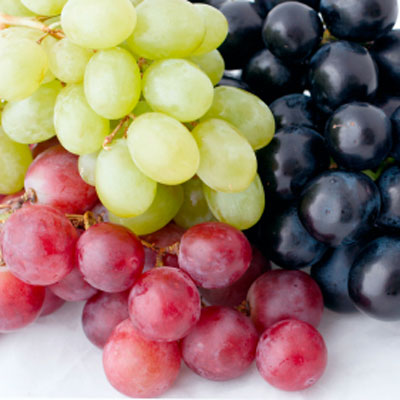Though there’s no one food that will reduce your risk of this disease, it’s the synergy between many nutrients 鈥?vitamins, minerals, phytochemicals, antioxidants 鈥?that’s likely to give you the most protection.
These 10 edibles pack a powerful anti-cancer punch.

3. Tomatoes
How they help:Tomatoes get their bright red color from an antioxidant called lycopene, which can protect cells from damage and kill those that aren’t growing properly, Doyle says.
They also may protect skin from cancer “by absorbing UV light,” says Wilhelm Stahl, Ph.D., professor and antioxidant researcher at the University of Dusseldorf in Germany.
Cancers they may fight: Breast, lung, endometrial, skin, prostrate and mouth Get your fill: Cooked or processed tomato-based foods 鈥?juice, sauce, paste, soup, even ketchup 鈥?have the most lycopene because heat releases more of this nutrient and allows your body to absorb it more easily.
Not a tomato lover? You can get lycopene in pink grapefruit and watermelon, too.
4. Garlic
How it helps:Garlic contains unique antioxidant phytochemicals called allyl sulfides that “seem to intervene in several steps of the cancer process,” says Karen Collins, R.D., C.D.N., nutrition advisor to the American Institute for Cancer Research. A 2007 study in the Journal of Nutrition suggests that these compounds inhibit colon tumor formation and cell growth.
Cancers it may fight:Stomach, esophageal, breast, lung and colon
Get your fill:Saut茅 veggies in a clove or two of garlic or add it to homemade salad dressings, dips, pasta sauces and soups.
Also, add garlic salt or powder to ground beef while making burgers or sprinkle it on pizza.
5. Cruciferous veggies
How they help:Cruciferous veggies (think broccoli, kale and cabbage) contain potential cancer fighters such as glucosinolates, crambene and indole-3-carbinol, says the American Institute for Cancer Research.
They also contain sulforaphane, which may keep cancer at bay by helping rid the body of carcinogens and inhibit the growth of cancer cells, according to research from the Roswell Park Cancer Institute in Buffalo, N.Y.
Cancers they may fight: Stomach, breast, skin, mouth, pharynx, larynx and esophageal.
6. Tea
How it helps: Tea is chock full of antioxidants called catechins, which lab studies have found may stop growth of cancer cells and reduce the size of cancerous tumors.
Cancers it may fight: Colon, liver, breast, prostate, lung, skin, bladder, stomach and pancreatic
Get your fill: Sip hot or cold green tea instead of coffee (it has less caffeine and no calories if you go sugarless). Black tea offers benefits, but green tea has three times more catechins, according to the American Institute of Cancer Research.
7. Flaxseed
How it helps: “Flaxseed contains an antioxidant called lignans, which may help the body rid itself of carcinogens, and
omega-3 fatty acids, which are believed to reduce inflammation and boost the body’s immune system,” says Krista Haynes, R.D., a staff dietitian with the Cancer Project, a nonprofit group in Washington, D.C.
Cancers it may fight: Colon, breast, skin and lung Get your fill: Try cooking or baking with flaxseed meal, flour and oil (all found at health food stores) or sprinkle ground flaxseed on cereal, oatmeal or salads.
8. Legumes
How they help: They may be tiny, but legumes such as peas, beans and lentils pack a big nutritional punch.
“They contain natural phytochemicals that are uniquely different from those in vegetables and whole grains,” Collins says.
These include saponins, protease inhibitors and phytica acid, which lab studies reveal may prevent the reproduction of cancer cells.
Fiber, too, can decrease your risk of colon cancer, according to a 2007 American Institute of Cancer Research report.
Cancers they may fight:Colon and stomach, among others
Get your fill:Top salads with lentils and peas, whip up lentil or pea soup, add pea pods to your stir-fry or nosh on plain old peanuts.
9. Whole grains
How they help:People who get their fill of whole grains have a 21%-43% lower risk of cancer than those who eat little to none, according to a study from the School of Public Health at the University of Minnesota.
Unlike refined grains, whole grains have the bran and germ layers, which are packed with antioxidants and other nutrients.
“They also contain fiber, which, when fermented in the colon, may produce substances that protect cells from cancer-causing agents,” Collins says.
Cancers they may fight:Breast, colon and stomach
Get your fill:Bake with whole-wheat flour and have oatmeal for breakfast.
Eat sandwiches made with whole-wheat bread (“whole wheat” should be the first word on the ingredient list) and replace white rice with wild or brown.
10. Dark-green leafy vegetables
How they help:These emerald-hued veggies contain folate and carotenoids.
“Carotenoids are antioxidants that aid cell-to-cell communication that controls cell growth, while folate is essential to protect our DNA, the starting point of any change that leads to cancer,” Collins says. ancers they may fight: Breast, skin, lung, stomach, mouth, pharynx and larynx
Get your fill:Add spinach to omelets and swap it for iceberg lettuce in salads (throw in romaine lettuce, leaf lettuce and Swiss chard, too). For dinner, lightly saut茅 mustard greens, collard greens and kale in olive oil and a squirt of lemon.
Back to Prevention and Treatment of Cancer
